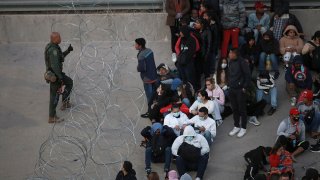
U.S. military prevent migrants from crossing into El Paso, Texas, as seen from Ciudad Juarez, Mexico, on Dec. 20, 2022.
Thousands of migrants gathered along the Mexican side of the southern border Wednesday, camping outside or packing into shelters as they waited for the U.S. Supreme Court to decide whether and when to lift pandemic-era restrictions that have prevented many from seeking asylum.
The limits on border crossings had been set to expire Wednesday before conservative-leaning states sought the top court’s help to keep them in place. The Biden administration asked the court to lift the restrictions, but not before Christmas. It is not clear when the court's decision will come.
The Texas National Guard took up positions in El Paso, while volunteers and law enforcement officers worried that some migrants could succumb to the cold. Nighttime temperatures have been in the 30s and will be even colder in coming days. The Roman Catholic diocese of El Paso, where nighttime temperatures are forecasted to be in the 20s this week, plans to open two more shelters for up to 1,000 people at area churches.
Jhorman Morey, a 38-year-old mechanic from Venezuela, warmed his hands by a campfire with a half-dozen other migrants on the southern side of the Rio Grande. He said he was waiting for a decision on the restrictions before attempting to cross into the U.S., though other migrants waded through shallow waters toward a gate in the border fence.
Get Southern California news, weather forecasts and entertainment stories to your inbox. Sign up for NBC LA newsletters.
“I want them to decide” on the public health rule known as Title 42, said Morey, who arrived in the Mexican city of Juarez, across the border from El Paso, six weeks ago. He now rarely eats after exhausting his savings.
Hundreds of migrants remained in line in Juarez. Others slept along the concrete embankments of the Rio Grande. A nearby shelter reached its capacity Tuesday night, stranding many outside.
As crowds gathered on the banks of Rio Grande, 1st Sgt. Suzanne Ringle said one woman went into labor and was assisted by Border Patrol agents. She added many children were among the crowd.
In Tijuana, which has an estimated 5,000 migrants staying in more than 30 shelters and many more renting rooms and apartments, the border was quiet Tuesday night as word spread among would-be asylum-seekers that nothing had changed. Layered, razor-topped walls rising 30 feet along the border with San Diego make the area daunting for illegal crossings.
Under the restrictions, officials have expelled asylum-seekers inside the United States 2.5 million times, and turned away most people who requested asylum at the border, on grounds of preventing the spread of COVID-19 under Title 42.
Immigration advocates have said that the restrictions go against American and international obligations to people fleeing to the U.S. to escape persecution, and that the pretext is outdated as coronavirus treatments improve. They sued to end the use of Title 42; a federal judge sided with them in November and set the Dec. 21 deadline.
Conservative-leaning states appealed to the Supreme Court, warning that an increase in migration would take a toll on public services and cause an “unprecedented calamity” that they said the federal government had no plan to deal with.
In response, Chief Justice John Roberts issued a temporary order to keep the restrictions in place.
The federal government then asked the Supreme Court to reject the states' effort while also acknowledging that ending the restrictions abruptly will likely lead to “disruption and a temporary increase in unlawful border crossings.”
States filed a response early Wednesday, arguing that letting the restrictions expire while the court reviews the lower court decision would cause "immediate, severe, and irreversible harms” to the states.
Though the Wednesday expiration date had been set weeks ago, the U.S. government asked for more time to prepare — while saying that it has sent more resources to the border and maintaining that the solution is not to extend the rule indefinitely.
About 23,000 agents are currently deployed to the southern border, according to the White House. The Biden administration said it has sent more Border Patrol processing coordinators, more surveillance and increased security at ports of entry.
Should the Supreme Court act before Friday, the government wants the restrictions in place until the end of Dec. 27. If the court acts on Friday or later, the government wants the limits to remain until the second business day following such an order.
As the decision went down to the wire, pressure built in communities along both sides of the U.S-Mexico border.
In El Paso, Democratic Mayor Oscar Leeser warned that shelters across the border in Juarez were packed to capacity, with an estimated 20,000 migrants prepared to cross into the U.S. El Paso rushed to convert large buildings into shelters, as the Red Cross brings in 10,000 cots.
“We will continue to be prepared for whatever is coming through,” Leeser said.
Texas said it was sending 400 National Guard personnel to the border city after local officials declared a state of emergency. Guard members used razor wire to cordon off a gap in the border fence along a bank of the Rio Grande that became a popular crossing point for migrants who waded through shallow waters to approach immigration officials in recent days.
Title 42 allows the government to expel asylum-seekers of all nationalities, but it’s disproportionately affected people from countries whose citizens Mexico has agreed to take: Guatemala, Honduras, El Salvador and, more recently, Venezuela, in addition to Mexico.
Santana reported from Washington, D.C. Juan Lozano in Houston and Alicia Fernández in Ciudad Juarez contributed to this report.